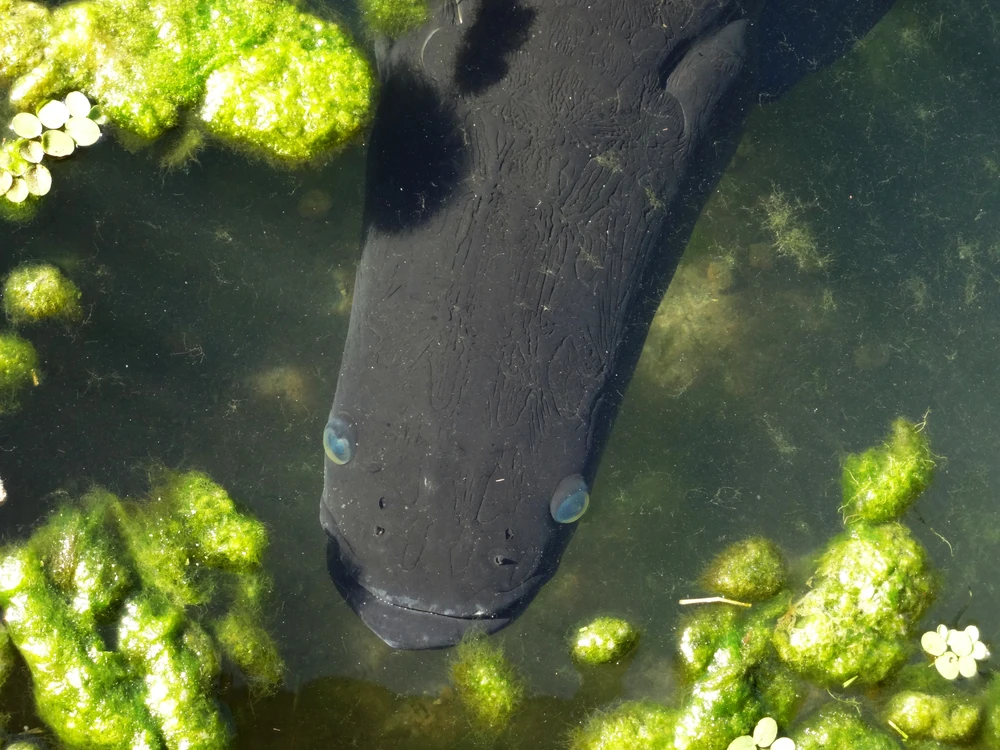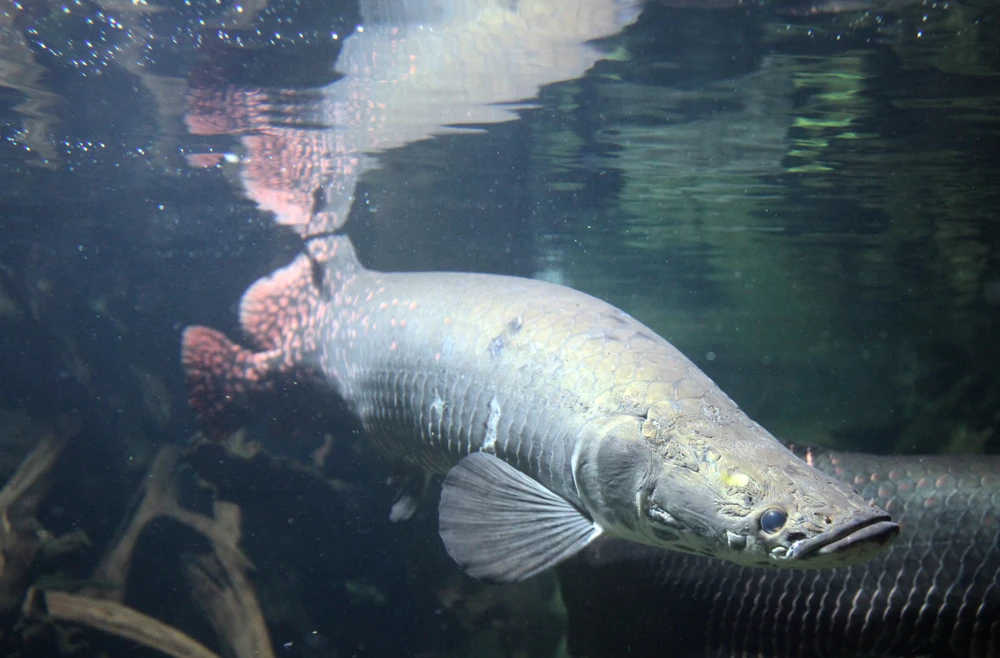Farming remarks
Arapaima gigas is a carnivorous fish that naturally inhabits the lowland with slow-flowing waters of the Amazon River basin in South America, occurring in Brazil, Colombia, Ecuador, Guyana, and Peru. It is a long-living species with parental care – especially by males – often referred to as one of the largest freshwater FISHES of the world. It was already introduced to Bolivia, China, Cuba, Mexico, Philippines, Singapore, and Thailand, but the main producer is still Brazil.
A. gigas has great economic and cultural importance, presenting some characteristics which are advantageous for aquaculture, such as the best growth rate among the Amazonian farmed fish species and a great tolerance to handling and ammonia concentrations. This fish is also tolerant to low dissolved oxygen levels due to its obligatory aerial breathing. A. gigas is harvested as JUVENILES and is commercialised mainly as fillet. The active fishing has reduced its population size and the occurrence of large IND over the years, especially around the populated regions of the Amazon. Because this fish appears in the CITES II section (strictly regulated and controlled commerce), its aquaculture development relies solely on spontaneous reproduction in captivity. Further research about home range, density of aggregation, and aggression in the wild is still needed. Moreover, nothing is known about a possible high-standard slaughter method for this species or the malformation rates under farming conditions.
For details see: WelfareCheck | farm (latest major release: 2022-08-12)
Related news
FishEthoGroup produced new spots of their Fish Talk's podcast programme on species from the fair-fish database. In series 18, you will find around 2 minutes of informative knowledge on Papyrocranus afer (Reticulated knifefish), Barbonymus schwanenfeldii (Tinfoil barb), and Arapaima gigas (Arapaima). For the first time, FishEthoGroup also covered a wild-caught species of our recently launched catch branch: Engraulis ringens (Peruvian anchoveta). And if you cannot get enough, also give their new episode of The Fish Mind programme a listen. In the current season about fish abilities, you may find episodes on memory, tool use, and self recognition. The new episode 4 is all about nest building in fishes. Enjoy and recommend!
From the Amazon river comes the new species for the FishEthoBase: Arapaima gigas, locally known as Pirarucu. This species is really a giant - it is considered one of the largest freshwater species worldwide. Especially depth and reproduction needs can be met in captivity, but there is more research needed on home range, aggregation, aggression, malformation rates, and a slaughter protocol to be able to assess the welfare potential in farms. Have a look at our analysis here.






Probably, we updated the profile. Check the version number in the head of the page. For more information on the version, see the FAQ about this. Why do we update profiles? Not just do we want to include new research that has come out, but we are continuously developing the database itself. For example, we changed the structure of entries in criteria or we added explanations for scores in the WelfareCheck | farm. And we are always refining our scoring rules.
The centre of the Overview is an array of criteria covering basic features and behaviours of the species. Each of this information comes from our literature search on the species. If we researched a full Dossier on the species, probably all criteria in the Overview will be covered and thus filled. This was our way to go when we first set up the database.
Because Dossiers are time consuming to research, we switched to focusing on WelfareChecks. These are much shorter profiles covering just 10 criteria we deemed important when it comes to behaviour and welfare in aquaculture (and lately fisheries, too). Also, WelfareChecks contain the assessment of the welfare potential of a species which has become the main feature of the fair-fish database over time. Because WelfareChecks do not cover as many criteria as a Dossier, we don't have the information to fill all blanks in the Overview, as this information is "not investigated by us yet".
Our long-term goal is to go back to researching Dossiers for all species covered in the fair-fish database once we set up WelfareChecks for each of them. If you would like to support us financially with this, please get in touch at ffdb@fair-fish.net
See the question "What does "not investigated by us yet" mean?". In short, if we have not had a look in the literature - or in other words, if we have not investigated a criterion - we cannot know the data. If we have already checked the literature on a criterion and could not find anything, it is "no data found yet". You spotted a "no data found yet" where you know data exists? Get in touch with us at ffdb@fair-fish.net!
Lorem ipsum
In the fair-fish database, when you have chosen a species (either by searching in the search bar or in the species tree), the landing page is an Overview, introducing the most important information to know about the species that we have come across during our literatures search, including common names, images, distribution, habitat and growth characteristics, swimming aspects, reproduction, social behaviour but also handling details. To dive deeper, visit the Dossier where we collect all available ethological findings (and more) on the most important aspects during the life course, both biologically and concerning the habitat. In contrast to the Overview, we present the findings in more detail citing the scientific references.
Depending on whether the species is farmed or wild caught, you will be interested in different branches of the database.
Farm branch
Founded in 2013, the farm branch of the fair-fish database focuses on farmed aquatic species.
Catch branch
Founded in 2022, the catch branch of the fair-fish database focuses on wild-caught aquatic species.
The heart of the farm branch of the fair-fish database is the welfare assessment – or WelfareCheck | farm – resulting in the WelfareScore | farm for each species. The WelfareCheck | farm is a condensed assessment of the species' likelihood and potential for good welfare in aquaculture, based on welfare-related findings for 10 crucial criteria (home range, depth range, migration, reproduction, aggregation, aggression, substrate, stress, malformations, slaughter).
For those species with a Dossier, we conclude to-be-preferred farming conditions in the Advice | farm. They are not meant to be as detailed as a rearing manual but instead, challenge current farming standards and often take the form of what not to do.
In parallel to farm, the main element of the catch branch of the fair-fish database is the welfare assessment – or WelfareCheck | catch – with the WelfareScore | catch for each species caught with a specific catching method. The WelfareCheck | catch, too, is a condensed assessment of the species' likelihood and potential for good welfare – or better yet avoidance of decrease of good welfare – this time in fisheries. We base this on findings on welfare hazards in 10 steps along the catching process (prospection, setting, catching, emersion, release from gear, bycatch avoidance, sorting, discarding, storing, slaughter).
In contrast to the farm profiles, in the catch branch we assess the welfare separately for each method that the focus species is caught with. In the case of a species exclusively caught with one method, there will be one WelfareCheck, whereas in other species, there will be as many WelfareChecks as there are methods to catch the species with.
Summarising our findings of all WelfareChecks | catch for one species in Advice | catch, we conclude which catching method is the least welfare threatening for this species and which changes to the gear or the catching process will potentially result in improvements of welfare.
Try mousing over the element you are interested in - oftentimes you will find explanations this way. If not, there will be FAQ on many of the sub-pages with answers to questions that apply to the respective sub-page. If your question is not among those, contact us at ffdb@fair-fish.net.
It's right here! We decided to re-name it to fair-fish database for several reasons. The database has grown beyond dealing purely with ethology, more towards welfare in general – and so much more. Also, the partners fair-fish and FishEthoGroup decided to re-organise their partnership. While maintaining our friendship, we also desire for greater independence. So, the name "fair-fish database" establishes it as a fair-fish endeavour.





